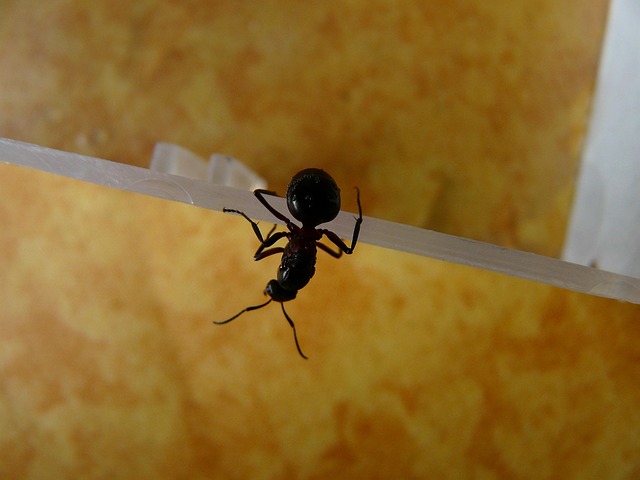Ants infiltrate homes and businesses through tiny cracks and openings, making indoor ant control a priority. Identify entry points like wall fractures, utility gaps, and door spaces, then employ strategies such as disrupting trails with repellents or baits to prevent further invasions. Customized prevention plans tailored to unique structures and environments involve inspections, gap sealing, targeted treatments, regular maintenance, and monitoring to ensure long-term indoor ant control. Continuous monitoring, maintenance, and proactive practices like cleaning and clutter removal are crucial for effective, lasting indoor ant control in both residential and commercial settings.
“Discover effective solutions for conquering ant infestations with tailored prevention plans. Understanding indoor ant control involves recognizing unique entry points and behaviors specific to each structure. This article guides you through crafting a customized plan, encompassing identifying weak spots, implementing strategic measures, and ongoing monitoring. Learn how to adapt general ant control practices to the particular needs of homes and businesses, ensuring long-term success in maintaining an ant-free environment.”
Understanding Indoor Ant Control: Identifying Entry Points and Behaviors
Ants are relentless intruders, often finding their way into homes and businesses through seemingly tiny openings. Understanding indoor ant control begins with identifying entry points, which can range from small cracks in walls to spaces around utility pipes and doors. These tiny gaps provide access to structures, allowing ants to explore and establish new colonies indoors. By pinpointing these entry points, pest control experts can implement targeted strategies to disrupt ant trails and prevent further invasion.
Recognizing ant behaviors is equally crucial for effective indoor ant control. Ants follow distinct paths, or trails, from their outdoor sources of food to their nest sites within buildings. These trails are often composed of pheromones, which serve as chemical markers guiding other ants. By disrupting these trails through the use of repellents or baits, professionals can break the communication network ants rely on for navigation and foraging, significantly hindering their ability to infiltrate and colonize indoor spaces.
Components of a Customized Ant Prevention Plan
A customized ant prevention plan for homes or businesses goes beyond standard, one-size-fits-all solutions. It involves a multi-faceted approach tailored to the unique structure and environment. The first step is conducting a thorough inspection to identify ant entry points and potential food sources. This could include finding cracks in foundations, gaps around doors and windows, or even hidden moisture issues that attract ants. Once these are pinpointed, strategies for exclusion—like sealing entries with caulk or repairs—are implemented to block their access.
Next, indoor ant control measures come into play. This might involve using baits strategically placed throughout problematic areas to lure and eliminate ants without harming pets or humans. For more severe cases, targeted applications of insecticides can be utilized, focusing on specific problem zones while minimizing impact on the environment and non-target species. Regular maintenance and monitoring are also crucial components—continuously assessing the property for new ant activity and adjusting strategies as needed ensures long-term success in keeping ants at bay.
Implementing Effective Ant Control Measures for Homes and Businesses
Implementing effective ant control measures is crucial for maintaining a pest-free environment, both in homes and businesses. The first step involves identifying the specific ant species infesting the area, as different ants have varying behaviors and preferences. Once identified, tailored strategies can be employed to disrupt their life cycles and prevent future invasions. For indoor spaces, this often includes sealing entry points like gaps around pipes, windows, and doors, as well as maintaining a clean environment free of food residues that may attract ants. Regular inspections are key to early detection of any ant activity.
In businesses, comprehensive indoor ant control requires a structured approach. This involves professional assessments to pinpoint ant trails and nest locations, followed by targeted treatments using eco-friendly products where possible. Regular maintenance checks and employee training on pest prevention practices can further fortify defenses against ants. By combining these measures, homes and businesses alike can achieve lasting indoor ant control, ensuring comfort and peace of mind.
Monitoring and Maintenance: Ensuring Long-Term Success of Ant Prevention Strategies
Effective ant prevention strategies require ongoing monitoring and maintenance for long-term success, especially in homes and businesses. Regular inspections are crucial to identifying potential entry points and early signs of an ant invasion. By staying vigilant, property owners can quickly address any issues before ants establish a thriving colony. Professional pest control experts recommend frequent checks, particularly after seasons of high activity, as ants adapt and find new ways inside.
Maintenance involves sealing gaps, repairing cracks, and ensuring proper waste management—key aspects of indoor ant control. Keeping areas clean and clutter-free reduces attractions for ants seeking food sources. Regular cleaning routines, combined with the removal of potential habitats like plants touching windows or doors, significantly hinder ant access. This proactive approach ensures that prevention measures remain effective over time, providing a comfortable and ant-free environment.
Customized ant prevention plans are the key to effective indoor ant control. By understanding ant behaviors, identifying entry points, and implementing tailored strategies for both homes and businesses, we can disrupt their life cycles and prevent infestations. Regular monitoring and maintenance ensure these measures remain successful over time, providing a peaceful and pest-free environment. For optimal indoor ant control, consult professionals to develop a plan suited to your unique needs.
